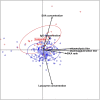Cheetahs have a stronger constitutive innate immunity than leopards
- PMID: 28333126
- PMCID: PMC5363065
- DOI: 10.1038/srep44837
Cheetahs have a stronger constitutive innate immunity than leopards
Abstract
As a textbook case for the importance of genetics in conservation, absence of genetic variability at the major histocompatibility complex (MHC) is thought to endanger species viability, since it is considered crucial for pathogen resistance. An alternative view of the immune system inspired by life history theory posits that a strong response should evolve in other components of the immune system if there is little variation in the MHC. In contrast to the leopard (Panthera pardus), the cheetah (Acinonyx jubatus) has a relatively low genetic variability at the MHC, yet free-ranging cheetahs are healthy. By comparing the functional competence of the humoral immune system of both species in sympatric populations in Namibia, we demonstrate that cheetahs have a higher constitutive innate but lower induced innate and adaptive immunity than leopards. We conclude (1) immunocompetence of cheetahs is higher than previously thought; (2) studying both innate and adaptive components of immune systems will enrich conservation science.
Conflict of interest statement
The authors declare no competing financial interests.
Figures


Similar articles
-
Diversity of selected toll-like receptor genes in cheetahs (Acinonyx jubatus) and African leopards (Panthera pardus pardus).Sci Rep. 2024 Feb 14;14(1):3756. doi: 10.1038/s41598-024-54076-y. Sci Rep. 2024. PMID: 38355905 Free PMC article.
-
Sex and species differences of stress markers in sympatric cheetahs and leopards in Namibia.Comp Biochem Physiol A Mol Integr Physiol. 2019 Jan;227:8-13. doi: 10.1016/j.cbpa.2018.09.002. Epub 2018 Sep 8. Comp Biochem Physiol A Mol Integr Physiol. 2019. PMID: 30201541
-
PREVALENCE OF VALVULAR REGURGITATIONS IN CLINICALLY HEALTHY CAPTIVE LEOPARDS AND CHEETAHS: A PROSPECTIVE STUDY FROM THE WILDLIFE CARDIOLOGY (WLC) GROUP (2008-2013).J Zoo Wildl Med. 2015 Sep;46(3):526-33. doi: 10.1638/2014-0155.1. J Zoo Wildl Med. 2015. PMID: 26352956
-
Cheetah paradigm revisited: MHC diversity in the world's largest free-ranging population.Mol Biol Evol. 2011 Apr;28(4):1455-68. doi: 10.1093/molbev/msq330. Epub 2010 Dec 23. Mol Biol Evol. 2011. PMID: 21183613 Free PMC article.
-
Conservation Genetics of the Cheetah: Lessons Learned and New Opportunities.J Hered. 2017 Sep 1;108(6):671-677. doi: 10.1093/jhered/esx047. J Hered. 2017. PMID: 28821181 Free PMC article. Review.
Cited by
-
Could care giving have altered the evolution of human immune strategies?Evol Med Public Health. 2024 Jan 25;12(1):33-49. doi: 10.1093/emph/eoae004. eCollection 2024. Evol Med Public Health. 2024. PMID: 38380131 Free PMC article.
-
Diversity of selected toll-like receptor genes in cheetahs (Acinonyx jubatus) and African leopards (Panthera pardus pardus).Sci Rep. 2024 Feb 14;14(1):3756. doi: 10.1038/s41598-024-54076-y. Sci Rep. 2024. PMID: 38355905 Free PMC article.
-
Evolutionary trade-off between innate and acquired immune defences in birds.Front Zool. 2023 Sep 8;20(1):32. doi: 10.1186/s12983-023-00511-1. Front Zool. 2023. PMID: 37684615 Free PMC article.
-
Comparative genomics of the Leukocyte Receptor Complex in carnivores.Front Immunol. 2023 May 10;14:1197687. doi: 10.3389/fimmu.2023.1197687. eCollection 2023. Front Immunol. 2023. PMID: 37234165 Free PMC article.
-
The application of allostasis and allostatic load in animal species: A scoping review.PLoS One. 2022 Aug 30;17(8):e0273838. doi: 10.1371/journal.pone.0273838. eCollection 2022. PLoS One. 2022. PMID: 36040981 Free PMC article. Review.
References
-
- Salafsky N. Improving the practice of conservation: a conceptual framework and research agenda for conservation science. Conserv. Biol. 16, 1469–1479 (2002).
-
- Kareiva P. & Marvier M. What is conservation science? Bioscience 62, 962–969 (2012).
-
- Wedekind C. Sexual selection and life‐history decisions: implications for supportive breeding and the management of captive populations. Conserv. Biol. 16, 1204–1211 (2002).
-
- Davies N. B., Krebs J. R. & West S. A. An introduction to behavioural ecology, 4 edn. (Wiley-Blackwell, Oxford, 2012).
-
- Salafsky N. & Margoluis R. A. Measures of success: designing, managing, and monitoring conservation and development projects(Island Press, Washington D.C., 1998).
Publication types
MeSH terms
Substances
LinkOut - more resources
Full Text Sources
Other Literature Sources
Research Materials

